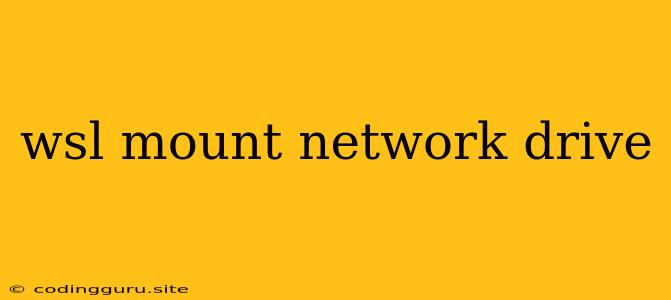WSL: Mounting Network Drives
Working with files on network drives within the Windows Subsystem for Linux (WSL) can be a valuable addition to your workflow. It enables you to seamlessly access and manipulate files stored on a remote computer, expanding your WSL environment's capabilities. However, mounting a network drive in WSL can sometimes present challenges, as the process differs from standard Windows file system interactions.
This article will guide you through the process of mounting network drives within WSL, outlining the steps and addressing common issues you might encounter.
Why Mount Network Drives in WSL?
Before we dive into the specifics, let's explore why you might want to mount network drives within your WSL environment:
- Shared Access: Network drives provide a convenient way to share files between multiple computers, including your Windows host and WSL distribution.
- Collaboration: If you're working on projects with others, mounting network drives allows you to easily share files and collaborate in real-time.
- Remote Resources: Accessing files stored on servers or other remote computers becomes easier with network drive mounts.
- File System Consistency: Mounting network drives within WSL allows you to maintain a unified view of your files across your Windows and Linux environments.
Steps to Mount Network Drives in WSL
Here's a breakdown of the process to mount a network drive in WSL:
-
Identify the Network Drive: Determine the exact path to your network drive. This usually follows the format
\\server\share_name, where "server" is the name of the computer hosting the shared folder and "share_name" is the specific folder's name. -
Create a Mount Point: Within your WSL distribution, choose a directory where you want to mount your network drive. This is the location on your Linux filesystem where the contents of the network drive will become accessible. For example, you could use
/mnt/network_drive. -
Mount the Drive: Employ the
mountcommand in your WSL terminal with the following syntax:sudo mount -t cifs //server/share_name /mnt/network_drive -o username=user,password=password- Replace "server" and "share_name" with the actual details of your network drive.
- Set the
usernameandpasswordarguments to the credentials required to access the network share.
-
Verify the Mount: Check that the mount has been successful by navigating to the mount point in your WSL terminal. You should be able to see the contents of your network drive.
Common Issues and Solutions
While mounting a network drive in WSL is generally straightforward, you might encounter some challenges:
- Authentication Errors: Ensure you are providing the correct username and password for the network share.
- Permission Issues: You might need to adjust permissions on the network drive or the mount point within WSL to gain access.
- Incorrect Drive Path: Verify that the network drive path is correctly specified, including any required capital letters.
- Missing CIFS Support: In some cases, you might need to install the
cifs-utilspackage in your WSL distribution to enable CIFS support.
Tips and Best Practices
- Automate Mounting: Consider using a script to automatically mount your network drive when WSL starts. This simplifies the process and ensures continuous access.
- Unmount Before Disconnecting: Always unmount your network drive using
sudo umount /mnt/network_drivebefore disconnecting from the network share to prevent data corruption. - Security: If your network drive contains sensitive data, enable appropriate security measures like encryption or access control lists.
Alternatives to Mounting
If you're encountering persistent difficulties with mounting network drives in WSL, consider these alternatives:
- SFTP: Utilize the Secure File Transfer Protocol (SFTP) to transfer files securely between your Windows host and your WSL distribution.
- SSH File Transfer: Leverage the SSH protocol to transfer files between your WSL distribution and a remote server.
Conclusion
Mounting network drives within WSL provides you with a convenient way to access and manage shared files within your Linux environment. By following the steps outlined in this guide, you can successfully mount network drives and enhance your WSL workflow. Remember to ensure proper authentication, manage permissions, and consider alternative methods if you encounter any roadblocks.
